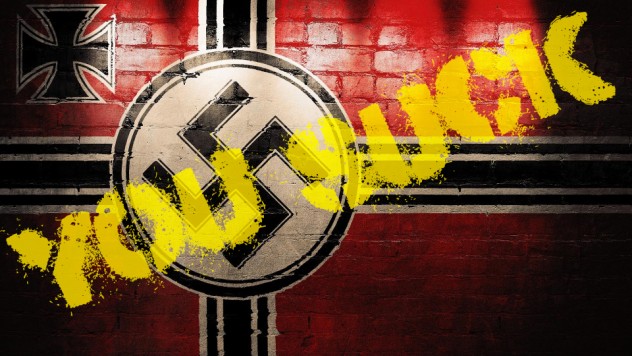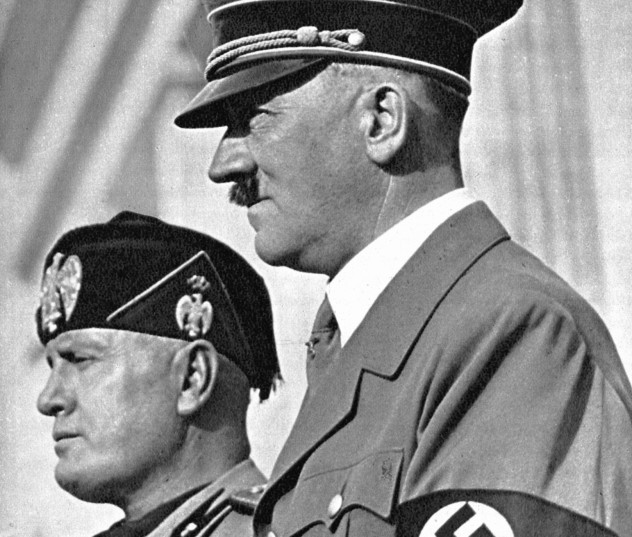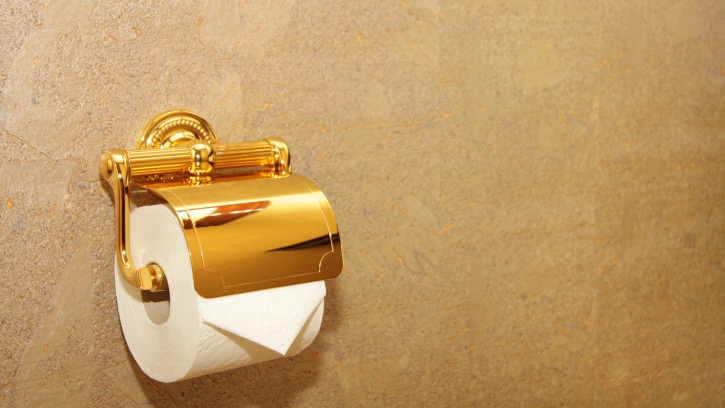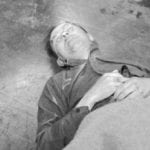 Weird Stuff
Weird Stuff  Weird Stuff
Weird Stuff  Our World
Our World 10 Ways Your Christmas Tree Is More Lit Than You Think
 Movies and TV
Movies and TV The 10 Coolest Stars to Set Sail on The Love Boat
 History
History 10 Things You Didn’t Know About the American National Anthem
 Technology
Technology Top 10 Everyday Tech Buzzwords That Hide a Darker Past
 Humans
Humans 10 Everyday Human Behaviors That Are Actually Survival Instincts
 Animals
Animals 10 Animals That Humiliated and Harmed Historical Leaders
 History
History 10 Most Influential Protests in Modern History
 Creepy
Creepy 10 More Representations of Death from Myth, Legend, and Folktale
 Technology
Technology 10 Scientific Breakthroughs of 2025 That’ll Change Everything
 Weird Stuff
Weird Stuff Ten Bizarre Facts About The Doge Meme
 Our World
Our World 10 Ways Your Christmas Tree Is More Lit Than You Think
 Movies and TV
Movies and TV The 10 Coolest Stars to Set Sail on The Love Boat
Who's Behind Listverse?

Jamie Frater
Head Editor
Jamie founded Listverse due to an insatiable desire to share fascinating, obscure, and bizarre facts. He has been a guest speaker on numerous national radio and television stations and is a five time published author.
More About Us History
History 10 Things You Didn’t Know About the American National Anthem
 Technology
Technology Top 10 Everyday Tech Buzzwords That Hide a Darker Past
 Humans
Humans 10 Everyday Human Behaviors That Are Actually Survival Instincts
 Animals
Animals 10 Animals That Humiliated and Harmed Historical Leaders
 History
History 10 Most Influential Protests in Modern History
 Creepy
Creepy 10 More Representations of Death from Myth, Legend, and Folktale
 Technology
Technology 10 Scientific Breakthroughs of 2025 That’ll Change Everything
10 Hilariously Childish Weapons We Used Against The Nazis
The Second World War was a period of darkness unmatched in human history, a titanic struggle against the forces of pure evil. Which is why it’s always a little surprising to realize that many of the Allies seemed to view the war less like a battle for the world’s future and more like they were Dennis the Menace and the Nazis were an army of Mr. Wilsons. Hence the use of such devastating weapons as…
10 Irremovable Graffiti

Graffiti was a popular low-risk way for the resistance to show their opposition to the Nazis, as well as undermine German propaganda. Recognizing this, Allied intelligence had started airdropping insulting stencils and paint behind enemy lines. Unfortunately, there was a problem: Those crafty Germans were simply removing the graffiti wherever they found it. So the British channeled huge resources into developing a form of obscene daubing that would be impossible to remove. They hit the jackpot with an ammonium-based paint that would etch into glass and be impossible to remove. This surefire war-winner was disguised as tubes of toothpaste and smuggled into occupied Europe, where it was particularly popular for writing insults on the windshields of German officer’s cars. However, there was one minor hitch when a shipment was accidentally sent to North Africa, where puzzled agents mistook it for real toothpaste with a “devastating effect on both teeth and morale.”
9 Itching Powder

As part of their remit to demoralize the enemy, the British Special Operations Executive (SOE) decided to take a cue from school pranksters and started mass-producing itching powder. The powder, which had a powerful irritant effect on exposed skin, was smuggled into occupied Europe disguised as talcum powder. There it was distributed to resistance members at laundries and clothing factories, where it could be secretly sprinkled over German uniforms. This wasn’t a small-scale operation: In October 1943, the SOE reported that 25,000 U-boat crew uniforms had been contaminated with itching powder. Apparently this was successful in getting at least one U-boat to return to port, as the crew had become convinced they were suffering from severe dermatitis.
Meanwhile, other SOE agents decided to get even more creative. The agency’s Stockholm office began gathering German envelopes from Swedes with relatives in occupied countries, filling them with itching powder, and sending them back into the German postal system. However the scheme reached its horrifying apex in Norway, where local resistance members started putting the powder into condoms intended for German troops. The contaminated condoms were shipped mainly to the Trondheim area, where the local hospital soon filled up with soldiers complaining of “painful irritation.”
8 Stink Bombs

The British also spent large sums developing a stink bomb called “the S-capsule” which could be broken into the pocket of a German coat to create a horrible stench. The smell clung even after multiple cleanings, and since winter clothing was in short supply in the German army, the poor soldier would either have to freeze or walk around reeking like a trawler fire.
Not about to be out-crazied by a bunch of limeys, the American Office of Strategic Services (OSS) launched the hilariously-named “Who Me?” program. This eventually produced a spray bottle that could be used on a German officer to produce a strong fecal smell that would “humiliate” him in the eyes of his men. Unfortunately “Who Me?” turned out to be so strong that it tended to cling to everyone in the area, including the poor guy trying to surreptitiously spray it. As such, the resistance members it was smuggled to generally refused to use it.
7 Fake Party Invitations

In 1944, SOE agents in Sweden were looking for ways to undermine Nazi support in the country when they suddenly saw their chance. The German embassy in Stockholm had arranged for the famous German actor and comedian Georg Alexander to give a gala, one-night-only performance of his new comic play, with tickets available only to an exclusive few. As it turned out, the play would be a hilarious farce—just not in the way the embassy had been hoping.
The SOE produced over 3,000 fake invitations to the play, and the swanky reception to be held afterward. The forgeries, which instructed the recipient to wear their very best evening dress, were then sent to known Nazi sympathizers around the country.
On the night of the gala, everything went as the SOE had planned. Thousands of Nazi-loving Swedes, flattered that their support was being recognized by the embassy, turned up in black tie only to be told that the tickets they were proudly clutching were fake, and that they would not be allowed in. The performance was delayed for hours by the angry mob outside, many of whom had traveled for hours, and now felt terribly snubbed. The foolish fascists became a laughingstock across Sweden.
6 Laxatives

The Atlantic coast of Norway was a desolate area with an economy based largely on pickled fish and, presumably, breath mints. So when Norway’s Nazi-controlled government announced that it was requisitioning the entire sardine catch people were understandably outraged. Luckily the resistance had a mole into the local Nazi headquarters who revealed that the sardines were going to be used to feed German troops—with the best of the catch reserved to provide tinned supplies to U-boat crews. And that’s when the resistance hit upon a plan so brilliant everyone in the country had to wear sunglasses for the rest of the war.
First they sent an urgent message to their contacts in British Intelligence requesting a strong laxative that could easily be added to vegetable oil without detection. The British, who had apparently decided not to ask too many questions after the whole itching-powder-in-the-condoms incident, shrugged and sent back all the croton oil they could get their hands on. Croton oil, in case you hadn’t guessed, is an extremely powerful purgative. The Norwegians snuck it into the canning factories, where it was added to the vegetable oil sardines are packed in. The sardines were then sent off to U-boat bases across the continent. Now painful diarrhea is bad at the best of times, but imagine it while packed onto a tiny submarine with a bunch of guys all suffering the same problem. Yeah.
British Intelligence was impressed enough by this success to start their own laxative-based campaign, using a substance called Carbachol. Official documents claimed that one gram of this could cause “diarrhea of epic proportions among 200 people.” A paper “hilariously” entitled Evacuation Against Evacuation was drawn up outlining a dual strategy. First, bottles of Carbachol were dropped over enemy units with notes pointing out that getting shot really sucked, and encouraging German soldiers to use the solution to fake dysentery and get a nice stay in hospital instead. Secondly, secret agents were to add the substance to German supplies. Sadly the war ended before this could be put into action.
5 Spreading Rumors

Early in the war, the British recruited the Daily Express journalist Sefton Delmer to run black propaganda operations against Germany. Delmer was the perfect man for the job, he spoke fluent German and during his time as Berlin correspondent for the Express he had come to know many senior Nazis, including Hitler. And he was also a tabloid journalist, which meant he had plenty of experience with making up scandalous stories. The station he set up was called Gustav Siegfried Eins, and right away it set out to produce the filthiest, most foul-mouthed, borderline obscene, broadcasts in Germany. His goal was to replicate the success of tabloids, which “by denouncing vice, secure a large circulation among those who wish to read about it.”
Gustav Siegfried Eins was supposedly the underground radio station of a group of right-wing German officers disgusted with the corruption and depravity of leading Nazis. Naturally that involved discussing said depravity in some detail. After one especially filthy broadcast involving “a German admiral, his mistress, five drunken sailors, and a lump of butter,” a shocked British politician wrote to the government to complain “If this is the sort of thing that is needed to win the war, why, I’d rather lose it.”
Eventually Delmer decided that the station had outlived its usefulness and decided to give it the best send-off he could come up with. A final recording was prepared in which the announcer was surprised mid-broadcast by the Gestapo, and shot dead after a short gun battle. The last words shocked listeners heard were a Nazi officer snarling, “got you at last, you swine!” Unfortunately the radio operator in charge of the station messed up and played the same recording an hour later, meaning that the announcer was apparently shot to death twice in a row.
4 Implying Hitler Had A Tiny Penis

Not that Delmer was content to keep things on the radio. To reinforce his stories of sexual misconduct among senior Nazis, he began doctoring photographs of Hitler to make it look as though he was exposing himself or masturbating in public. Artists like Marion Whitehorn spent hours painstakingly drawing genitals onto pictures of the Fuhrer. For added effect, the penis shown was always circumcised to add credence to the rumors Hitler was secretly of Jewish descent. When the SS began circulating pamphlets denouncing the images as forgeries, Delmer saw his chance to take things to the next level. He produced a mock SS pamphlet containing a photo of a grinning Hitler with a truly massive penis. Below the picture was a caption condemning it as fake, since “everyone knows the Fuhrer does not possess anything of the kind.”
3 Putting Hitler’s Face On Toilet Paper

Even more so than the SOE, the OSS had a reputation for being willing to consider any scheme, however crazy, which might undermine the enemy war effort. So, late in the war, when the OSS office in Rome realized that the enemy was experiencing a severe wiping-material shortage, they jumped all over it. The department began producing anti-Nazi toilet paper, which would then be dropped into Germany or placed in the bathroom of trains traveling from neutral Switzerland. Some of the rolls were printed with anti-Nazi text and some truly terrible toilet humor (a sample: “Comrades! Enough with all this…” well, you get the idea). Others just had a picture of Hitler’s face and the words (“This side up!“)
2 Bombarding Hitler With Pornography

Continuing with the “let’s annoy Hitler into surrendering” strategy of the last few entries, the OSS came up with a plan that was deranged even by their low, low standards. They knew taking Hitler out would strike a devastating blow to the Nazis. But killing him would be almost impossible and ran the risk of turning him into a martyr. So instead they just decided to drive him crazy. With porn.
See, the agency’s crack team of psychologists had concluded that Hitler was pathologically prudish about sex. They argued that if Hitler was suddenly exposed to a huge quantity of hardcore pornography he would be driven to a nervous breakdown. So the OSS R&D division (known as “the Choirboys”) sprang into action, assembling a “mountain” of German pornography.
At this point, it’s probably worth remembering that there was an actual war raging across the globe, while these guys sat around flicking through Bavarian erotica and arguing about which edition of “Busty Berlin Babes” was more likely to destroy the menace of fascism once and for all.
Shockingly, the plan fell apart almost as soon as the OSS tried to put it into action. They had decided that the best way to get the porn to Hitler was to have a bomber drop it on his bunker. When the air raid alert ended, the Fuhrer would wander outside, see the lingerie catalogs littering the landscape, and instantly be driven to Lovecraftian madness. An unsuspecting Air Force colonel was called to OSS headquarters, where the plan was enthusiastically explained to him. He wasn’t a fan.
In fact, the colonel apparently left shouting that the entire agency was a bunch of maniacs and that the Air Force wouldn’t risk the life of a single pilot on the scheme. Let’s all take a moment to remember that brave officer, apparently the only sane man in the entire military brass.
1 Parody Newspapers

When the Nazis invaded Belgium they had taken over the country’s largest newspaper, Le Soir, and converted it to a mouthpiece for propaganda. But on November 9, 1943, readers who stopped to pick up a copy at one of Brussel’s many newsstands were in for a surprise. At first glance the paper appeared totally normal. However on closer inspection every story was revealed to be subtly, or not-so-subtly, mocking the German occupiers.
For example, the movie section advertised such upcoming films as Olympiad Part 1: The Marathon From El Alamein To Sidi Barani, featuring Field Marshall Rommel in his greatest role; The Unsinkable, starring the British navy; and Where Is The Editor, a detective film starring Himmler and the Gestapo. There were pieces perfectly mimicking the style of the paper’s usual propagandists, but gradually devolving into surreal nonsense or digs at the increasingly precarious Nazi military situation. The obituary section was just filled with the names of prominent collaborators.
The parody, quickly dubbed Le Faux Sour, was actually the work of the Belgian Resistance. Hoping to inspire more Belgians to join the movement, they had come up with a brilliant non-violent protest. Recruiting cartoonists, writers, and printers, they managed to produce a perfect replica of Le Soir. The fake paper was then delivered to newspaper kiosks around Brussels. They had originally hoped to stop the actual newspaper from being published at all that day, but their agents were unable to torch the newspaper vans and a planned British air raid on the printers actually showed up a day late. Nonetheless, by working at breakneck speed, the resistance were able to get their paper into the kiosks first. By the time the real paper arrived, word of the parody had already spread. It eventually sold 50,000 copies, generating valuable support for the resistance and turning the Nazis into a laughing stock.
Sadly, there was a tragic epilogue to the story. Two of the planners, Ferdinand Wellens and Theo Mullier, were captured by the Gestapo, tortured, and executed. They are remembered as heroes of the resistance and the men who made Belgium laugh in its darkest hour.
Alex has also written for Cracked.com. If you enjoy being vaguely underwhelmed you can follow him on his shiny new Twitter account.








